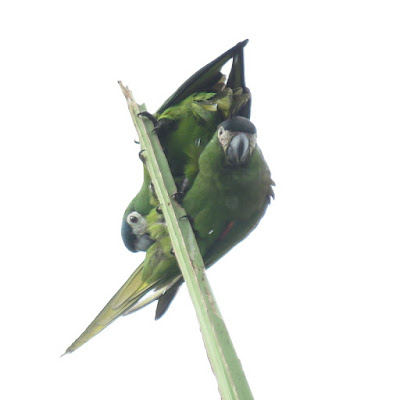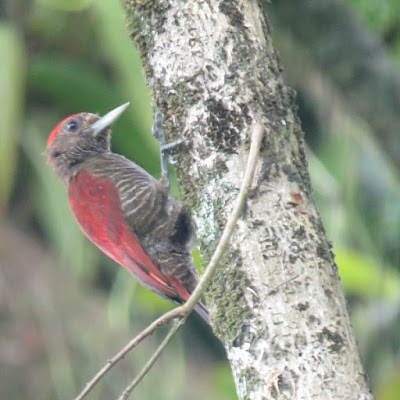20 March. Soon after 04:00 the proprietor of the Piarco Suites made the first of two runs to take the six of us (Nick Preston, Matt Eade, Nick Gardner, Paul Hopkins, Stuart Reeds and me) to the airport for our 06:10 flight to Georgetown. It was uneventful and we arrived at 07:10. After a short delay at Immigration we collected our bags, I declared my biscuits at Customs and were met by Ron Allicock's Georgetown fixer Francis at the airport. Today was an arrival day and Ron would be joining us that evening. Francis took us to a minibus that would be our transport for the early part of the trip and we were driven to the Status International Hotel in Georgetown. We were given rooms, Nick and mine smelled like a sewer and we quickly switched to another. Francis told us how to get to the Botanical Gardens, only 15-20 minutes walk away, and we left our bags and headed out at 09:15. On the way we saw Wing-barred Seedeater and by the entrance Festive Amazon and Yellow-chinned Spinetail - an encouraging start. I had heard stories of birders being mugged in the remoter parts of the gardens and we were told the same by one of the gardeners working there as we headed away from the more formal grounds. We stayed on the main track and stuck together. In open habitat this worked well for birding and we saw Zone-tailed Hawk, Red-shouldered Macaw, Yellow-crowned, Orange-winged and Mealy Amazons, White-bellied Piculet, Blood-coloured Woodpecker, Spotted Tody-Flycatcher, a pair of unexpected Cinnamon Attilas, Red-eyed Vireo, Black-capped Donacobius, Yellow Warbler and Yellow Oriole. At about 12:45 and with little warning it started to rain heavily. The wet season was still a month away so this was something we were not expecting and not really prepared for - several umbrellas had been left in the hotel. The rain was so heavy is started coming through my umbrella while we were encroached upon by standing water, reminiscent of a flood in a Winnie-the-Poo story (it must have made quite an impression at the time for me to remember it 55 years later). We found some shelter under a tree for an hour or so before the rain started to ease off, being entertained at one stage by a passing local who was seemingly undertaking a long and heated conversation with an imaginary friend standing in the open in the pouring rain. At least it wasn't cold. We decided to head back having seen most of what we could expect too and once back at the Status International spent the rest of the day drying out. My deck shoes definitely turned out to be inappropriate footwear.
 |
| sunrise over Trinidad through a dirty Caribbean Airlines window, the clouds should have been a warning it might be wet |
 |
| Yellow-chinned Spinetail |
 |
| Red-capped Cardinal |
 |
| Festive Amazons outside Georgetown Botanical Gardens. There is some debate about these birds origins although over a dozen are often present |
 |
| Red-shouldered Macaws |
 |
| Macaws are often entertaining with their antics |
 |
| Black-capped Donacobius |
 |
| Blood-coloured Woodpecker, a near endemic and our main target in the Botanical Gardens |
 |
| Cinnamon Attila, we were surprised to find a pair in the Botanical Gardens. Most welcome as it was a new bird for me, my 5th in Guyana |
 |
| Rufous Crab Hawk drying out at Hope Beach, its primaries really needed it |
 |
| dried out a bit and showing the wing patch |
 |
| our breakfast stop |
 |
| Mahiaca River |
 |
| Green-tailed Jacamar |
 |
| Black-collared Hawk along the Mahiaca River |
 |
| Hoatzin eating leaves along the Mahiaca River |
 |
| clumsy, uniquely primative and with a whacky crest, what more could you ask of a National bird? |
 |
| heading into the mangroves for another abortive rail attempt |
 |
| Rufous Crab Hawk in the mangroves |
 |
| we were closer than the hawk was comfortable with |
 |
| washed up plastic bottles at Hope Beach |
 |
| Solitary Sandpiper at Hope Canal |
 |
| Georgetown view from our balcony |
 |
| Orange-breasted Falcon high on its pylon |
 |
| Matt Eade's superb photo of a Grey-winged Trumpeter crossing the road north of '58mile snatchet' (see http://seafordbirding.blogspot.co.uk/2017/04/guyana-22317.html) |






No comments:
Post a Comment
Note: only a member of this blog may post a comment.